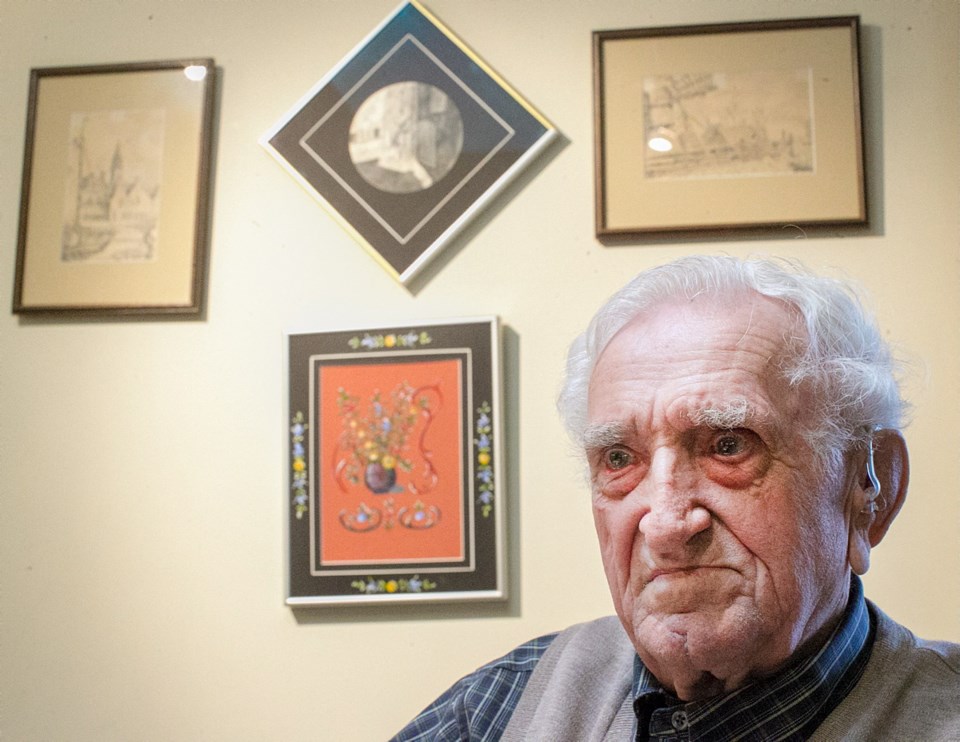As the Canadians fought their way close to Deventer, Peter Reitsma climbed onto the roof for a better look.
Maybe not the wisest move, given all the gunfire, but after five years of Nazi occupation, the sight of Allied soldiers working their way toward the Dutch town was too tempting for the teenager to resist.
As the battle intensified, Reitsma retreated to the cellar. At one point, he popped out, saw some men in strange uniforms — Canadians! — but they waved him back inside. The fighting in the street was still too hot.
When Reitsma and his dad emerged again, an armoured vehicle rumbled into view. This time, Reitsma’s ex-army father, who had fought the invaders in May 1940, saluted the three soldiers on board. In that instant, Reitsma says, a connection was made. “They saluted back,” the Saanich man, now 94, recalls.
It wouldn’t be the last connection forged between the Dutch and all those young Canadians who drove out the Germans in the spring of 1945. It was, in fact, the beginning of a special relationship.
Today is the 75th anniversary of Liberation Day, a big event in the Netherlands — and a big one for a generation of Dutch Canadians, too.
About 150,000 Dutch — including 2,000 war brides — immigrated to Canada in the post-war era. Many landed here in the capital region, where the Netherlands Association of Vancouver Island still has its own clubhouse on Vanalman Avenue in Saanich.
When the bells of the Netherlands Centennial Carillon in front of the Royal B.C. Museum ring out over the Inner Harbour, remember they were a gift from B.C.’s Dutch community in thanks for Canada’s role in the liberation.
About 175,000 Canadians helped free the Netherlands. More than 7,600 died doing so. Vancouver Island’s Canadian Scottish Regiment was in the thick of the fighting from the battle for the Scheldt Estuary — a bloody, waterlogged slog through northern Belgium and southwestern Holland in the fall of 1944 — right through to the liberation. The fight for Wagenborgen alone cost 64 CanScots casualties between April 21 and 23, 1945. Place names like Schalkhaar and Deventer — where Reitsma perched on that rooftop — dot the regimental history.
To appreciate how the Dutch felt about the Canadians, you have to understand what the Netherlands went through: curfews, seized property, forced labour, deportation of Jews to death camps, the hongerwinter of 1944, when maybe 20,000 starved to death.
Take Reitsma. He was 14 when, fleeing his home town with his possessions in a couple of pillowcases, he had to dive for cover as German fighters planes strafed the road. Emerging from the ditch, he found the bodies of dead Dutch soldiers.
Toward the end of the war, he found himself in the countryside, ducking the raids in which young men were snatched up for forced labour. When German search parties neared, dairy farmers would bang milk cans together as an alarm, and Reitsma would hide in the woods.
It’s hard to explain to someone who has never lost their freedom what it feels like to lose, then regain it, he says. “It’s something even today, so many years later, it still hits you when you talk about it.”
When he saw those Canadian soldiers tossing cigarettes and chocolates — unimagined luxuries — to the throngs of people who poured out of their houses, it was like shedding a crushing weight. “All of a sudden that fell off our shoulders,” he says.
Jack Adrichem, who sits on the board of the Netherlands Association, feels the same way. He was just six years old when the war ended, but still retains the memories: shunted from town to town, staying in a barn, then sleeping five kids to a bed in a storage building. Using a thumbnail to crush the lice and fleas that fell out of his hair. “I remember 1944, the winter of hunger, when nothing was available to eat.”
When his brother came home with a single slice of bread, it became the family’s supper, his mother cutting it in seven pieces. By the end of the war, all their furniture was gone, burned as fuel.
It all left wounds inside. “When I was 10 years old, I already had lines in my forehead.”
When Adrichem sees images of gaunt, big-eyed Syrian children, he thinks “That was me” and despairs for them.
Perspectives like his are fading. They still gather to play Dutch card games at the clubhouse on Vanalman, but there are only about 35 members now, down from 180 at the peak. All are over age 80. Gone are the days when a tugboat would bring Sinterklaas into Victoria Harbour each Dec. 5.
The Dutch don’t forget, though. Bulb growers in the Netherlands developed a new flower, the Canadian Liberator tulip, and 740,000 were planted across Canada last fall. The Peace Tulip Garden at the corner of Government and Belleville honours the Canadians who served in Holland.
Adrichem will also be at that corner at noon today — alone, as per pandemic guidelines — to place a wreath at the cenotaph.
Do the Dutch still remember those Canadian soldiers? “Oh, absolutely,” he says.



